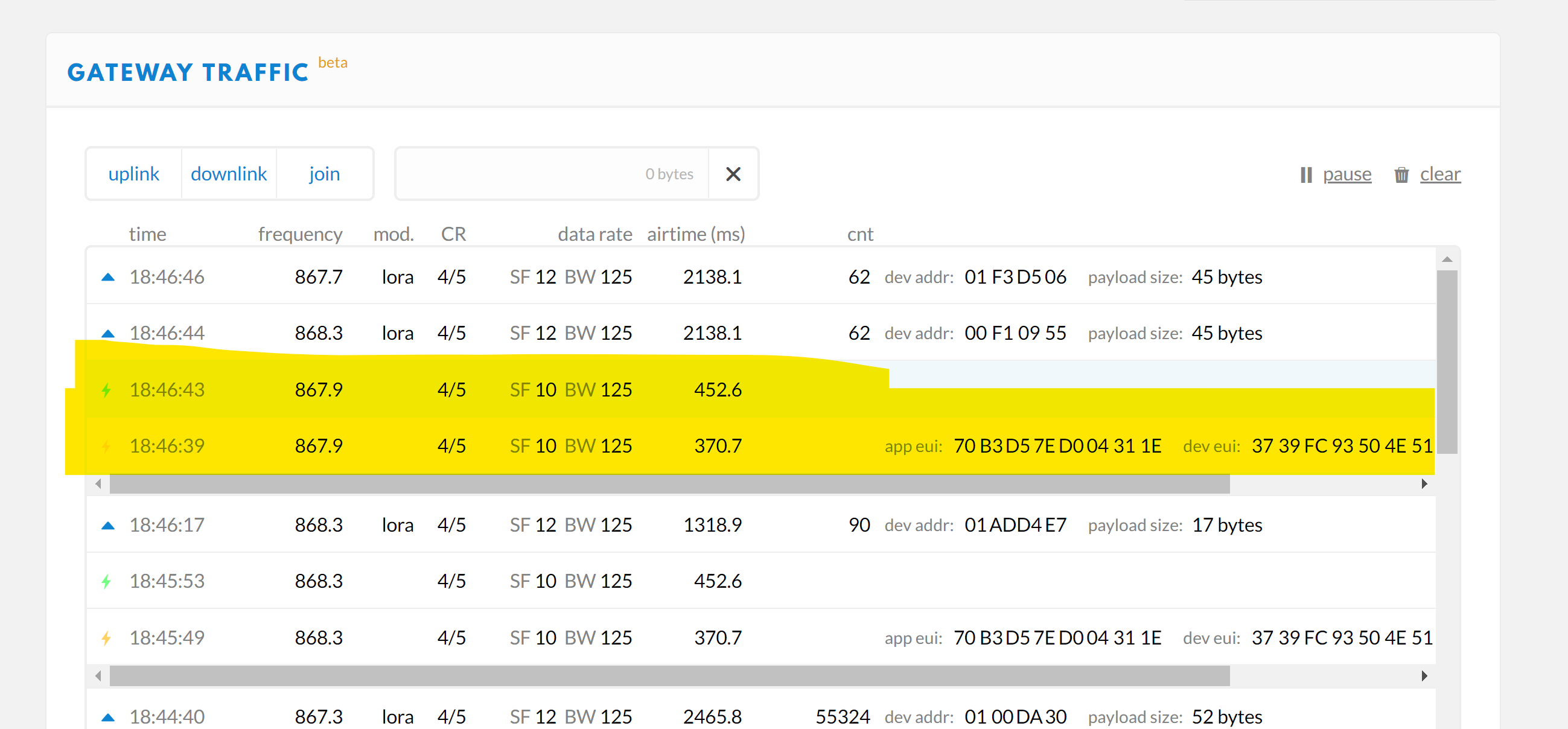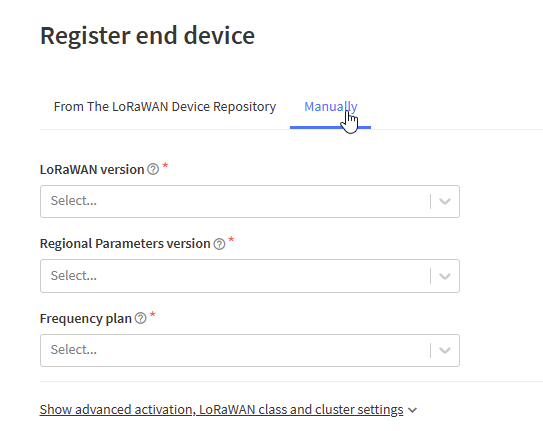So there is no problem and it is all working???
Yes sir, but this is for OTAA activation method. And my topic is ABP, I will work on Replay attack prevention for ABP activation method. Actually, the topic of my PhD is about the security of LoRaWAN.
If you’ve got OTAA working which is the hard one for LMiC with the endianness, I am right out of ideas for why the ABP one is a problem.
Alright sir thank you so much for your constant support. Thanks a lot
Just wanna show you the gateway info.

You really need to go and read the basics of LoRaWAN.
You have highlighted an OTAA join. ABP does not join.
This is fundamental to LoRaWAN and if you don’t understand the difference, you replay attack research will never happen.
What resources or teaching have you been given on any of this?
Do you understand that for ABP you should be looking for the DevAddr that you copied from the device page when you set it up and put in the LMiC settings??
Dear sir, I am sorry you seem to misunderstood me, I was talking about OTAA join and not ABP. I just showed in the snapshot that the gateway receives join request for OTAA method. I thinks its my mistake for not mentioning detailed information. I am sorry
Mentioning detailed information is at the heart of research.
As I said, I have no further ideas on my ABP isn’t working so I’m going to have to leave this to someone else.
I am very thankful to you, sir. You already helped me a lot. You are extremely cooperative person.
I’m not sure which Ph.D degree but before trying to do anything with LoRaWAN security, the very minimum is that you first grasp the LoRaWAN basics and e.g. get a simple LoRaWAN node working, first with ABP, then with OTAA.
Basics, so no additional stuff for sensors etc. whatever.
From a Phd.D student I would expect that you try to understand the underlying technology (to a fair amount) first, and from there come up with targeted questions and provide all relevant information.
From this thread I do get a strong impression though that your primary goal is mainly to get your current assignment working so you can move on to your next step.
To be honest, I mainly see questions like ‘please help me get this code working’ instead of asking questions like “what do I need to…”, “why…”, “where can I find information about…”, “do I understand correctly…”, “is my assumption correct…” etc. and so whith all respect I get the impression that you want to let others do your own homework.
LoRaWAN is not simple and many aspects are involved. Several experienced people have tried to help you in this thread, but you seem not to pick up all advice given. @kersing told you to have a look at LMIC-node, but apparently you have not.
As a Ph.D student an important aspect is doing research. How hard is it to research information that is provided ‘handed onto a silver platter’?
Have a good look at LMIC-node. It is well structured and well documented and supports your Adafruit Feather M0 LoRa board right out of the box. With LMIC-node you can get a working node up and running literally in minutes (once you have read the documentation and are already familiar with the TTN console).
Once you have it up and running you can start extending or modifying it to your needs and liking, e.g. add code for reading a temperature sensor. You don’t have to use LMIC-node for your own code but it will at least show how things can be done to get them working (and contains the experience of several lessons learned).
If you need additional help, first research and experiment and then come up with targeted questions supplied with sufficient information so others can use their time more efficient to provide any answers.
Thank you so much for your kind suggestions. Indeed, I appreciate your suggestions. I would like to bring into your kind notice that I have done all these basics steps and tried LMIC basic example “Hello, world!” via TTN-ABP sketch. LoRaWAN is a very complex field even a small problem takes from weeks to months.
Again thanks for your kind words.
That’s why LMIC-node was created to make it easy to get a node up and running. ![]()
The problem is now with the join accept. The node is kept near the gateway but still, no join accept message has been received. Although, this is not my target abut s you suggested practicing on various examples will make me perfect in LoRaWAN. My goal is to connect the LoRa node via ABP.
Good luck with your research and journey on the forum.
(Much information is already present on the forum to help you solve those issues).
Using the Search option and checking the Categories will be most useful.
Thank you sir, Yes I am studying every post on the forum may be any of them could fit on my problem. Thanks for your encouragement.
I’ve outlined several times that ABP does not join which you are either not reading, forgetting or ignoring. But mostly you just don’t seem to absorb the information.
@bluejedi was referring to LMIC-node - a quick forum search would have found all the detail on that.
Strange, when I moved from LoRa to LoRaWAN, I spent two or three days to read the documentation and do the tutorials and implemented LMiC almost straight away.
You seem totally blind to your lack of knowledge. Try reading all the docs that TTN spent so much time creating that you could have found at any time.
Hi sorry to interrupt in the conversation.
I have also have a couple of feather m0 lora, does any body know how to configure “add the device” in an application. it does not appear as one of the supported devices and I have no idea of how to add the device manually.
Maybe you have been able to configure it in TTN Console V3, and your knowledge would be greatly appreciated.
Regrads, Victor.
It’s just generic device so the docs & form aren’t that special, you could configure any device with them, as we did for devices in the repository before it existed.
So use the LoRaWAn version appropriate to the firmware, frequencies appropriate to your region, get the console to create the EUI’s and AppKey and put that in to the firmware.
Thanks Nick, I will give it a try this afternoon.

Hi Vsanjuan,
I’ve been using the MCCI Catenna LoRaWAN library Version 3.3.0, this by default will be LoRa MAC Version 1.0.3 for library version 3.3.0, so in TTNv3, select “manual” then select MAC version 1.0.3 and then the second PHY will be only one available and auto-selected - which narrows it down, only do this if you are using the same library as I have been.
Then select country/frequency plan that suits where the device will be deployed - this matches exactly what you programmed the node too, e.g. MCCI you have to select frequency plan in lmic_project_config.h from the library before compiling (best to edit config file, save and then re-open the project) then in the code state for US915 and AU915 for example the subband 2 (at least this is still manual process in MCCI 3.3.0 library because of the vastness of AU915 etc) to select this use the line " LMIC_selectSubBand(1); " in the void setup section, where (1) = Subband 2, (0) = Subband 1, if your frequency plan doesn’t need sub-band control (e.g AS923) then comment out the subband section in void setup.
I’ve successfully done around 6 OTAA DIY devices with Feather M0 LoRa RFM95 with AU915, measuring PM2.5, DHT-22, SHT31 and thermistors etc using this code as basis - no major issues, best the check the example sketches too - DHT22 is a good one to show how the code measures and prepares sensor data for transmission.
There is new version of the MCCI library (like 4.0.0) but I personally have not tried it, at least I had to update all my node devices to MCCI 3.3.0 a few months ago in order for them to even join on TTNv3 / TTS CE compared to TTNv2, as MAC version 1.0.2 on the old library was not working in V3, even though it all matched.
Regards
Toby